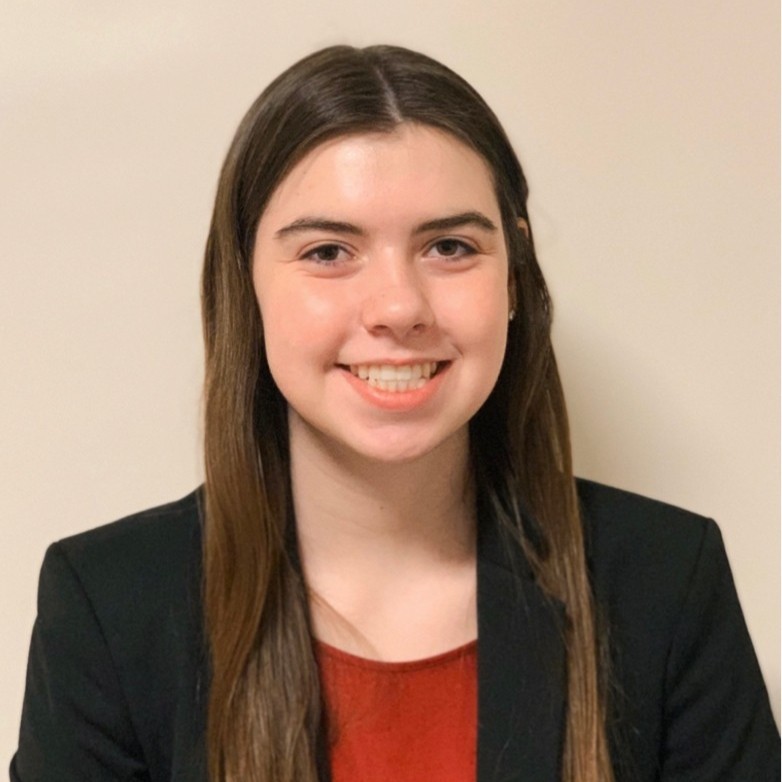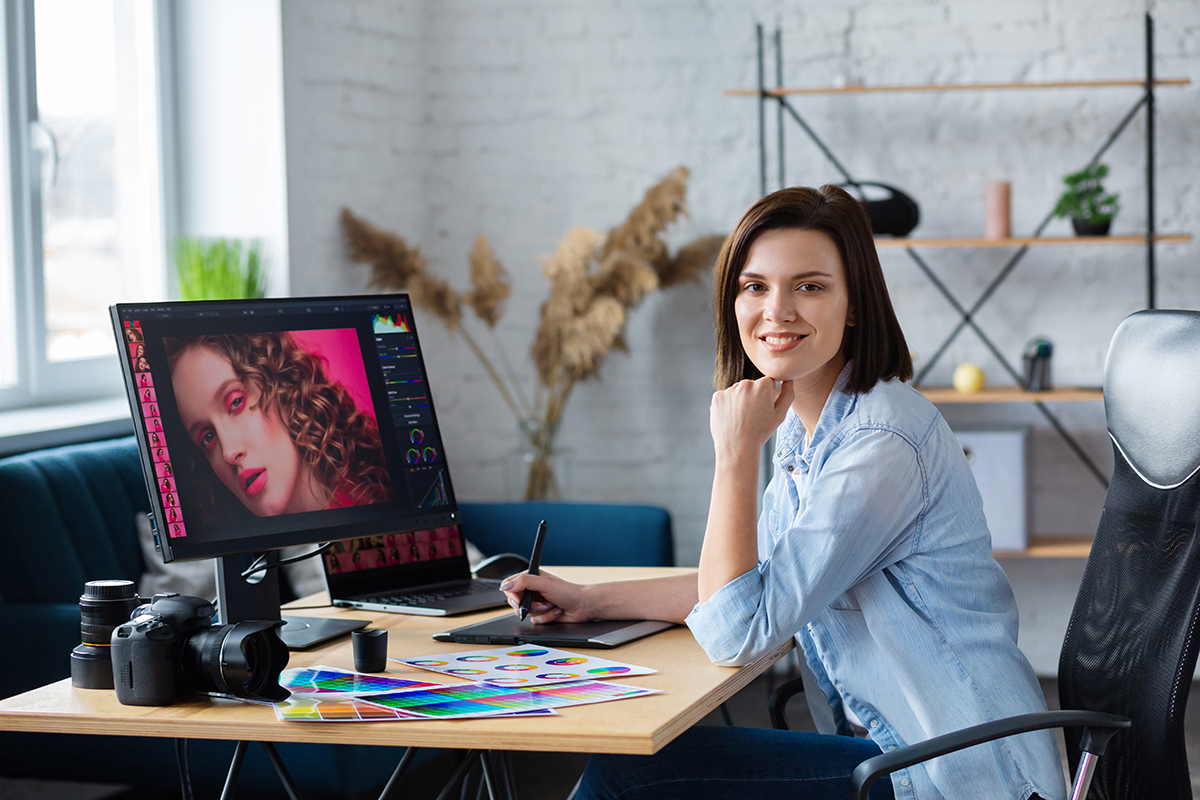A cover letter is an important part of the job application process that accompanies your resume and provides additional information about your qualifications and experience.
Its purpose is to introduce yourself to the potential employer, highlight your relevant skills and experience, and explain why you are the best candidate for the job. A well-written cover letter can help you stand out from other applicants and increase your chances of getting an interview.
Make a good impression with your cover letter, because it is frequently the first thing a potential employer sees. It provides an opportunity for you to showcase your personality, creativity, and communication skills. In addition, a cover letter can help explain any gaps in your resume or address specific requirements mentioned in the job posting.
When writing a cover letter, it is important to remember that your letter should not only showcase your design skills but also highlight your relevant experience and qualifications. By taking the time to research the company and tailoring your letter to the job requirements, you can create a compelling cover letter that sets you apart from other applicants and increases your chances of getting the job.
If you want to boost your chances of moving further in the hiring process, then keep reading because this article will explain:
- What a graphic designer’s cover letter is
- Tips for writing an effective cover letter
- The essential components of a cover letter
- The best practices for writing a cover letter that gets noticed.
What is a Cover Letter?
Cover letters are documents that accompany a resume when applying for jobs.
The purpose is to introduce the applicant to the potential employer, highlight their design skills and experience, and explain why they are the best candidates for the job.
A well-written cover letter should showcase the applicant’s creativity, communication skills, and attention to detail. It should also demonstrate their knowledge of design principles, software applications, and industry trends. The letter should be tailored to the specific job requirements and company culture, and explain how the applicant’s skills and experience make them the ideal candidate for the position.
Why Should You Write a Cover Letter?
The purpose of a cover letter is to introduce the applicant to the potential employer, highlight their design skills and experience, and explain why they are the best candidates for the job. A well-written cover letter serves as an efficient marketing tool since it directly addresses the hiring manager or recruiter. It gives insight into how your skills, qualifications, and motivations align with the company’s goals.
Tips for Writing an Effective Cover Letter
A well-written cover letter could be the difference between getting that job and not getting it. So below are a few prerequisites you would want to familiarize yourself with before you begin writing your letter:
Use proper formatting
Keep the layout simple and clean, with plenty of white space. Use bullet points and short paragraphs to break up the text and make it easier to read.
Font
Please choose one of the appropriate formal fonts, such as Arial, Calibri, Verdana, or Times New Roman, and remain consistent throughout your document to appear professional and make it easy to read.
Font size
Font size is also essential, and it is advised to only use 11- or 12-point fonts because they are the easiest for most readers to read.
Spacing
Professional cover letters are configured with a space between text lines and words, two spaces between paragraphs, and two spaces between each section.
Margins and alignment
Align the texts to the left of the page with margins of one inch. Most cover letters position the greeting, body, and compliments to the left, while specific cover letter templates may have the headings centered or positioned to the right.
Confirm sending format
If you intend to submit your cover letter electronically, you must be aware of the proper file format to use when storing it. Submit your document as a PDF unless specified otherwise.
Use proper salutations
Address the letter to the hiring manager or recruiter by name, if possible. If you do not know their name, use a generic greeting such as “Dear Hiring Manager.”
Professional tone
Use a professional tone and language, avoiding slang or casual language. Use proper grammar and punctuation throughout the letter.
Sections of the Cover Letter
A well-written cover letter has several essential components and a straightforward structure. The following are the sections that are included in a cover letter:
Header
Every such cover letter begins with a header that contains your appropriate contact details. The header should start with your name, and then list your email address, phone number, home address, and social media links. Your header and resume header must be identical.
Greetings
The salutation or greeting should address the hiring manager by their name. Research the hiring manager’s name for each vacancy to demonstrate that you have given your application some thought and consideration.
Use “Ms,” not “Mrs” or “Miss,” and where the manager’s name cannot be found, use “Dear Graphic Design Team Manager,”
As a general principle, never use “To whom it may concern” in your cover letters, as this conveys a lack of interest.
Introduction
An engaging introduction is sure to capture any hiring manager’s attention. For example, share your enthusiasm for this job, top achievements, and anticipation for the position.
Body
The body of your letter starts with an explanation of your letter’s purpose in the first paragraph. The middle paragraph should discuss what you can offer the employer and show your suitability for the job by explaining your experience and qualifications. Lastly, express your enthusiasm for the job.
Sign off
Sign off with a call to action, inviting the recruiting manager to review your portfolio and résumé. Reiterate your qualifications and interest, and thank the manager for honoring your application.
TIP
Another excellent technique to reinforce your unique selling points in the cover letter is to add a PS at the bottom of your letter. You can include an achievement here to pique the hiring manager’s curiosity.
How to Write a Cover Letter
Knowing what to write in a cover letter can be daunting; however, with the proper guidance, your cover letter has the power to convey aspects of your skills that your resume cannot.
Continue reading to get an idea of how to write the cover letter:
Introduce yourself
The introduction should be brief and to the point. You should start by introducing yourself and stating the position you are applying for. You could also briefly mention how you found out about the position or why you are interested in the company.
EXAMPLE
An engaging introductory paragraph will look like this:
Dear Katherine Alaina,
As a skilled graphic designer with [insert number of years] years of experience, I am excited to apply for the graphic designer position at [insert company name]. I have a passion for creating visually stunning and effective design solutions, and I believe that my skills and experience make me a strong candidate for the position.
Mention your skills and expertise
In this part of your cover letter, you should describe your skills and expertise as a graphic designer. This could include your ability to work with different design tools and software, your knowledge of design principles and theory, your ability to work collaboratively with others or team members, or your ability to manage multiple projects and meet deadlines.
EXAMPLE
A detailed description of your skill set will look like this:
I have gained a lot of expertise in web design and motion graphic design while working as a UI/UX designer offering freelancing services. In addition, my intense interest in helping others express themselves has been the driving force behind all I have accomplished. As a result, I am confident I can help SkyVfx Solutions achieve a wider customer base and innovate new projects.
Mention your experience
Employers want to know they are selecting competent workers, so a candidate with appropriate training and experience would easily capture their attention.
In this section, you should highlight your relevant experience in graphic design. You should provide specific examples of projects you’ve worked on and the skills you used to complete them. This could include your experience working on branding, marketing materials, websites, user interfaces, or other types of design projects. You should also highlight any experience you have working with different design tools and software, such as Adobe Creative Suite or Sketch.
EXAMPLE
Working in an industry that accommodates freelancing, I have honed my skills by working with several top creative design firms like Venetian Design Group, Hafdala Designs, Monty Vfx, etc., which have helped me build an impressive portfolio of creative designs. In addition, these freelance jobs allowed me to expand and build on my skills through various pieces of training and the acquisition of industry certifications like the Google UX certificate and the HNC graphic design certificate.
Write about your accomplishments
Include at least one paragraph as a substantial accomplishment in your cover letter to engage the employer, establish an emotional connection, demonstrate results, and become immediately remembered.
EXAMPLE
During my time as a graphic designer, I have had the opportunity to work on a variety of projects and have achieved several accomplishments that I am proud of. For example, I was able to create a visually stunning brand identity for a new company that accurately reflected its values and mission. I also developed a user interface for a complex software system that was well-received by users and improved their overall experience.
Creativity and innovation
Creativity and innovation are key skills. In this section, you should mention any innovative solutions you have developed for design challenges or examples of how you have taken a creative approach to a project. You could also mention any awards or recognition you’ve received for your design work.
Describe why you want to work here
When mentioning why you want to work for the company, you could highlight some of its key values or mission statements that resonate with you. You could also mention any recent projects or initiatives that the company has worked on that you find particularly interesting or inspiring.
Additionally, if you have any personal or professional connections to the company, such as previous work experience or industry networking events, you could mention this in your cover letter as well. This can help establish a personal connection with the hiring manager and demonstrate your commitment to the company.
EXAMPLE
I am excited to apply for the graphic designer position at XYZ Company. I have been an admirer of your work for years, and your commitment to creating visually stunning and innovative design solutions is what initially drew me to your company. I was particularly impressed by your recent branding project for [insert project name], and the way you were able to bring the client’s vision to life through creative design solutions.
Mention any attached documents
If you were asked to include any attached documents before you conclude the cover letter, politely mention this to avoid overlooked errors. If possible, provide a link to your online portfolio or attach a few samples of your work. This will allow the hiring manager to see your design skills and style. Make sure your portfolio showcases your best work and demonstrates your design skills and expertise.
EXAMPLE
I have attached a document containing the details of outstanding projects I was part of. These projects led to the development of new industry software and products, which consumers have widely accepted.
Closing
End your cover letter by thanking the hiring manager for considering your application, and expressing your enthusiasm for the position. Let them know that you’re available for an interview and look forward to the opportunity to discuss your qualifications further. You could also mention that you will follow up on your application to check on its status.
Graphic Designer Cover Letter Template
[Your Name]
[Your Address]
[City, State, Zip]
[Your Email Address]
[Your Phone Number]
[Date]
[Recipient’s Name]
[Recipient’s Title]
[Company’s Name]
[Company’s Address]
[City, State, Zip]
Dear [Recipient’s Name],
I am writing to express my interest in the Graphic Designer position listed on [where you found the job posting], at [Company’s Name]. With a [brief description of your degree or professional training] in Graphic Design and [number of years] years of hands-on experience in [mention specific areas, e.g., digital branding, UI/UX design], I am confident in my ability to contribute effectively to your team and help [Company’s Name] achieve its branding and design goals.
During my tenure at [Previous Employer’s Name], I successfully managed multiple projects from concept through completion. A few highlights of my career include:
- Developed [describe a significant project you led or contributed to], which [result of the project, emphasizing any increase in engagement, brand visibility, or sales].
- Collaborated closely with the marketing team to create and implement effective design strategies that increased [specific outcome, e.g., customer engagement, website traffic].
- Utilized a variety of software and design tools (mention specific software like Adobe Creative Suite, Sketch, etc.), staying abreast of current trends and technologies to deliver cutting-edge designs.
I am particularly drawn to [Company’s Name] because [mention something you admire about the company, such as their commitment to sustainability, innovative approach to design, or their company culture]. I am eager to bring my background in [mention any specific type of design or market you specialize in] and my passion for [mention a design trend or technique you’re passionate about] to your talented team.
Enclosed is my resume, which provides a more detailed overview of my achievements. I am looking forward to the opportunity to discuss how my creative vision and design expertise can help [Company’s Name] achieve its upcoming design goals. I am available at your earliest convenience for an interview and can be reached at [Your Phone Number] or [Your Email Address].
Thank you for considering my application. I am excited about the possibility of contributing to [Company’s Name] and am eager to bring fresh ideas and a unique perspective to your team.
Warmest regards,
[Your Name]
Sample Cover Letter
Dear Jordan Lee,
I am writing to express my enthusiasm for the Graphic Designer position at Pixel & Frame Studios, as advertised on Indeed. With a Bachelor of Fine Arts in Graphic Design from Design University and three years of dedicated experience at a fast-paced digital marketing agency, I have honed my skills in creating visually compelling designs that drive engagement and convey clear brand messages. My expertise in Adobe Creative Suite, alongside a proven track record of successful project management, positions me as a fitting candidate to contribute to your creative team’s success.
At Creative Dynamics, I embraced the challenge of transforming client ideas into impactful digital content, including websites, social media graphics, and branding materials.
Highlights of my contributions include:
- Lead Designer for a major rebranding project for a national retail chain, which resulted in a 25% increase in online customer engagement within the first six months post-launch.
- Successful management of over 50 design projects from inception to delivery, consistently meeting tight deadlines and client specifications.
- Implementation of user-centered design principles in the creation of web and mobile interfaces, significantly improving user experiences and client satisfaction ratings.
What excites me most about the opportunity at Pixel & Frame Studios is your team’s commitment to innovation and excellence in design. I am particularly drawn to your recent work on [specific project or aspect of the company’s work], which I believe sets a new standard in the industry. I am eager to bring my blend of creativity, technical proficiency, and passion for design to contribute to such inspiring projects.
I am confident that my background in working collaboratively with cross-functional teams to deliver high-quality design solutions makes me a strong match for this role. I am particularly adept at balancing multiple projects simultaneously, a crucial skill for thriving in dynamic, creative environments like Pixel & Frame Studios.
Enclosed is my resume, which provides further detail about my professional achievements. I am looking forward to the opportunity to discuss how my experience, skills, and passions align with the goals of Pixel & Frame Studios. I am available for an interview at your earliest convenience and can be reached at 214-567-8901 or via email at emma.clarkson@designmail.com.
Thank you for considering my application. I am excited about the possibility of contributing to the innovative projects at Pixel & Frame Studios and am keen to bring fresh ideas and a unique perspective to your esteemed team.
Warm regards,
Emma Clarkson
Analysis
This cover letter effectively employs job application strategies. The applicant begins with a strong expression of enthusiasm and quickly outlines qualifications, including a relevant degree and experience at a digital marketing agency. This sets a credible foundation for their candidacy.
The letter details the applicant’s skills and accomplishments, emphasizing expertise in Adobe Creative Suite and a track record of successful project management, crucial for the role. Specific projects are highlighted to demonstrate the applicant’s ability to turn client ideas into impactful designs, showcasing both creative and technical proficiency.
By expressing admiration for the company’s commitment to innovation and excellence, the applicant shows they have researched the company and align their interests with its values. The ability to work collaboratively and manage multiple projects is asserted, underscoring skills essential for thriving in a dynamic creative environment.
The letter concludes with an invitation for further discussion and a note of thanks, indicating professionalism and eagerness to engage. Overall, it effectively balances showcasing the applicant’s qualifications and experience with knowledge of and enthusiasm for the company, making a compelling case for their candidacy.
Free Templates
Below are the cover letter templates:
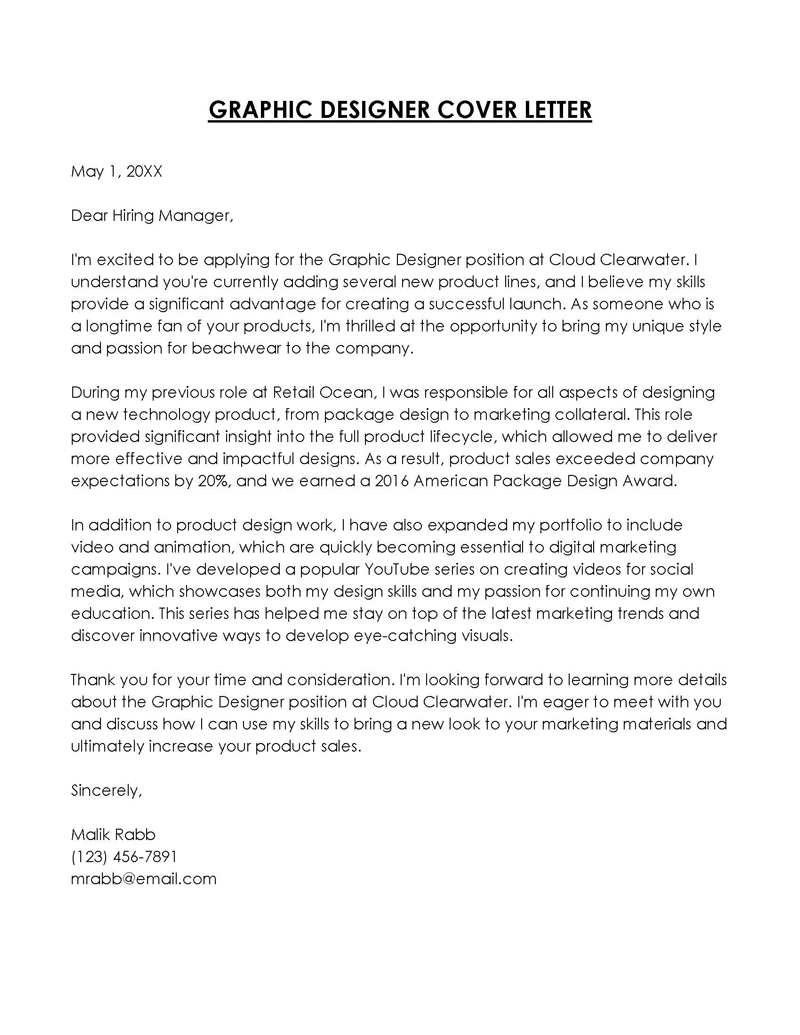
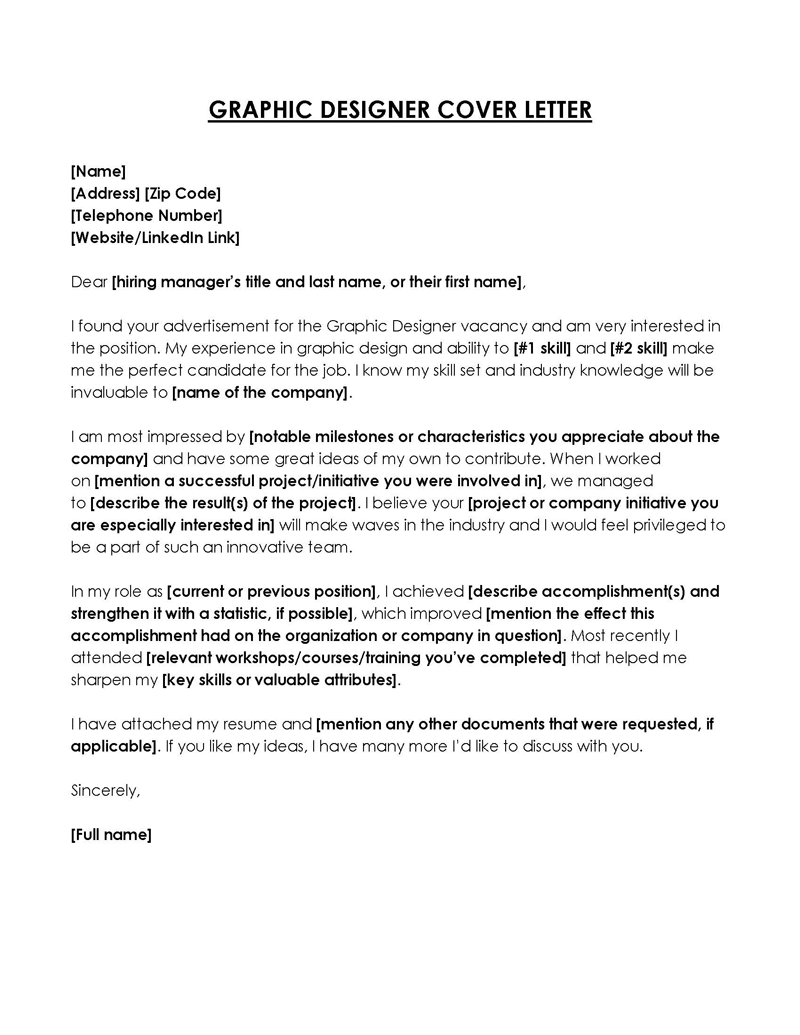
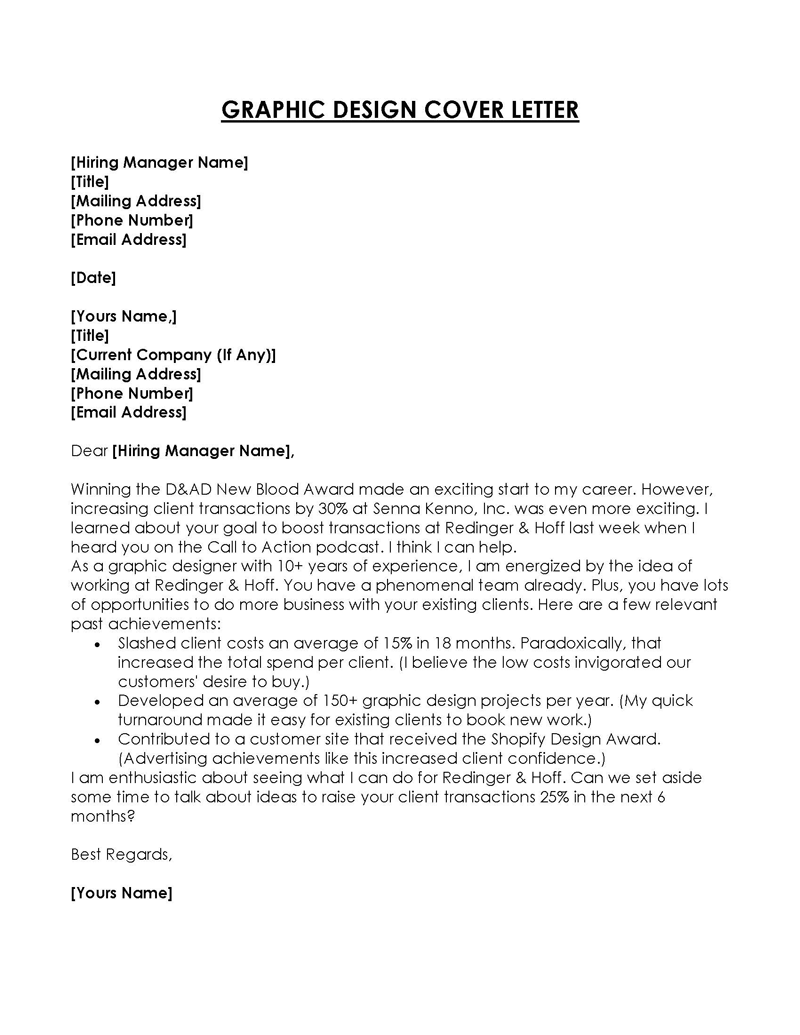
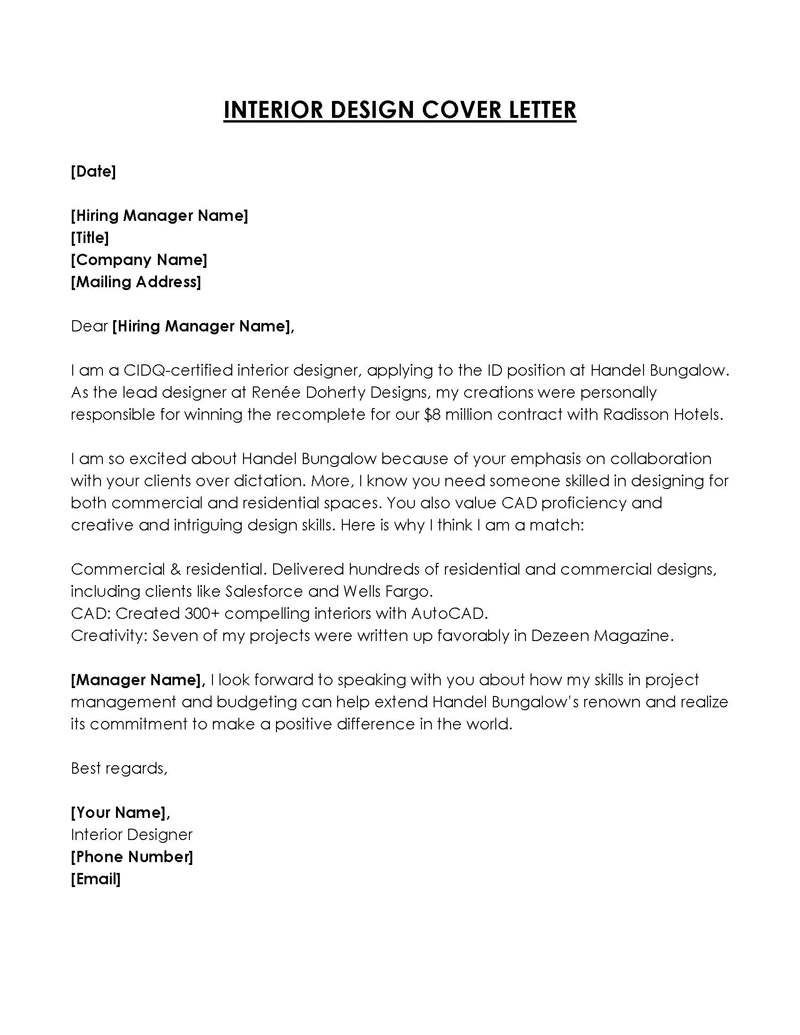
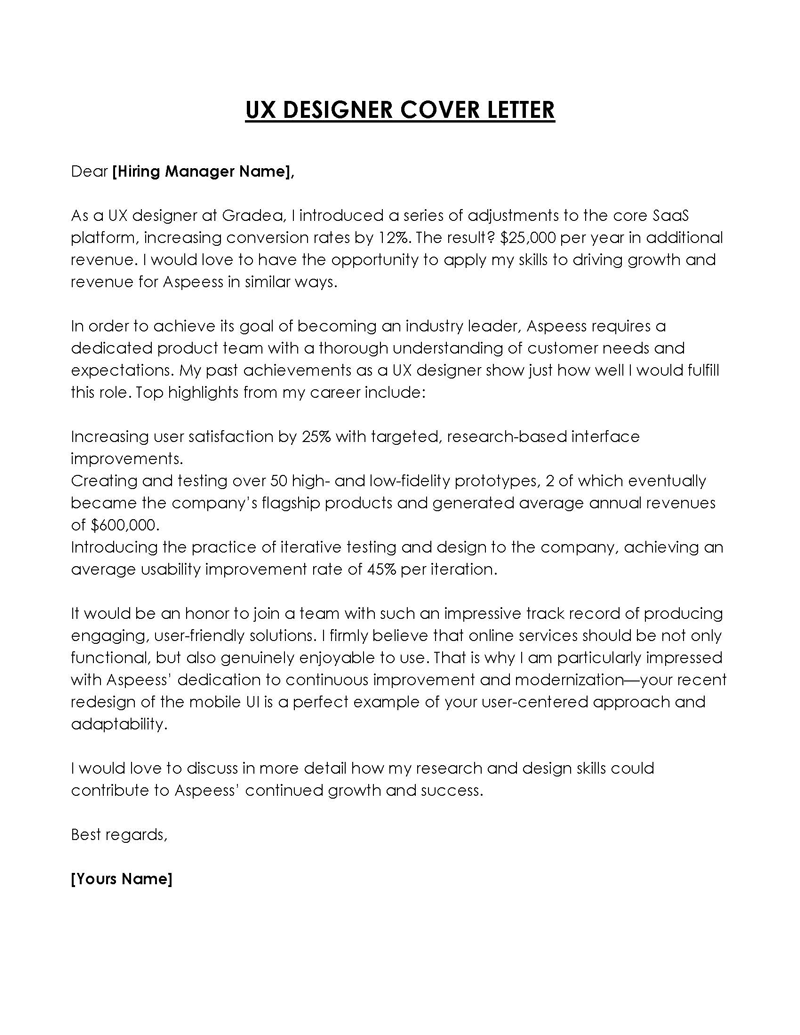
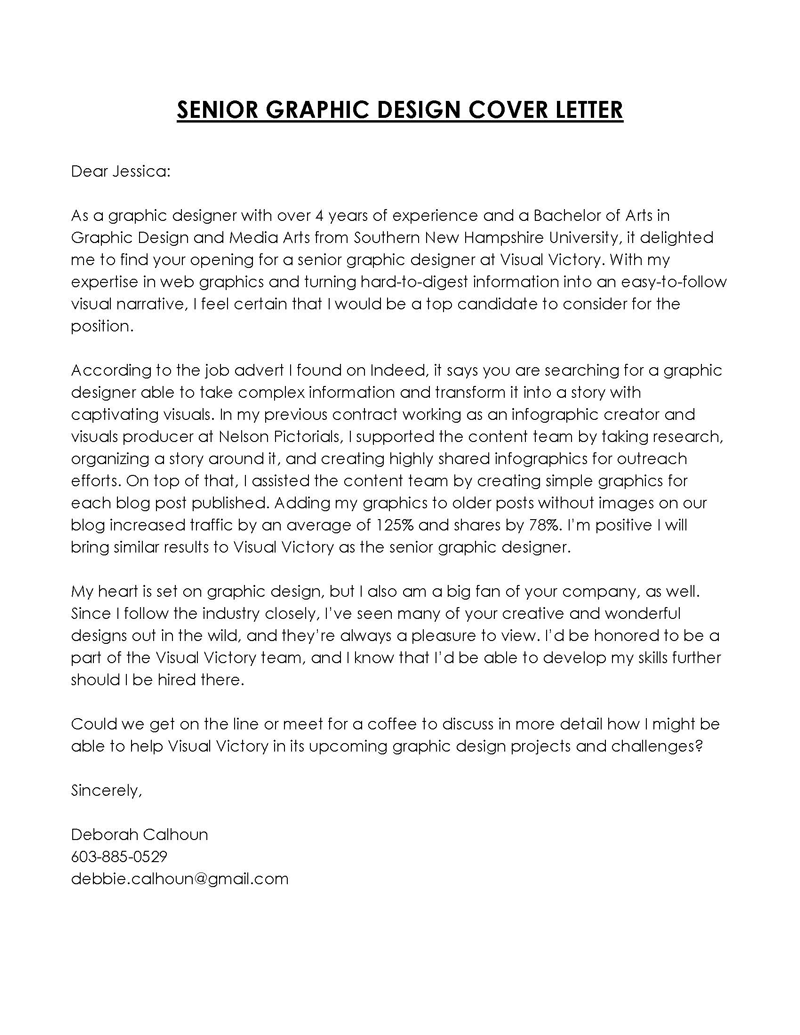
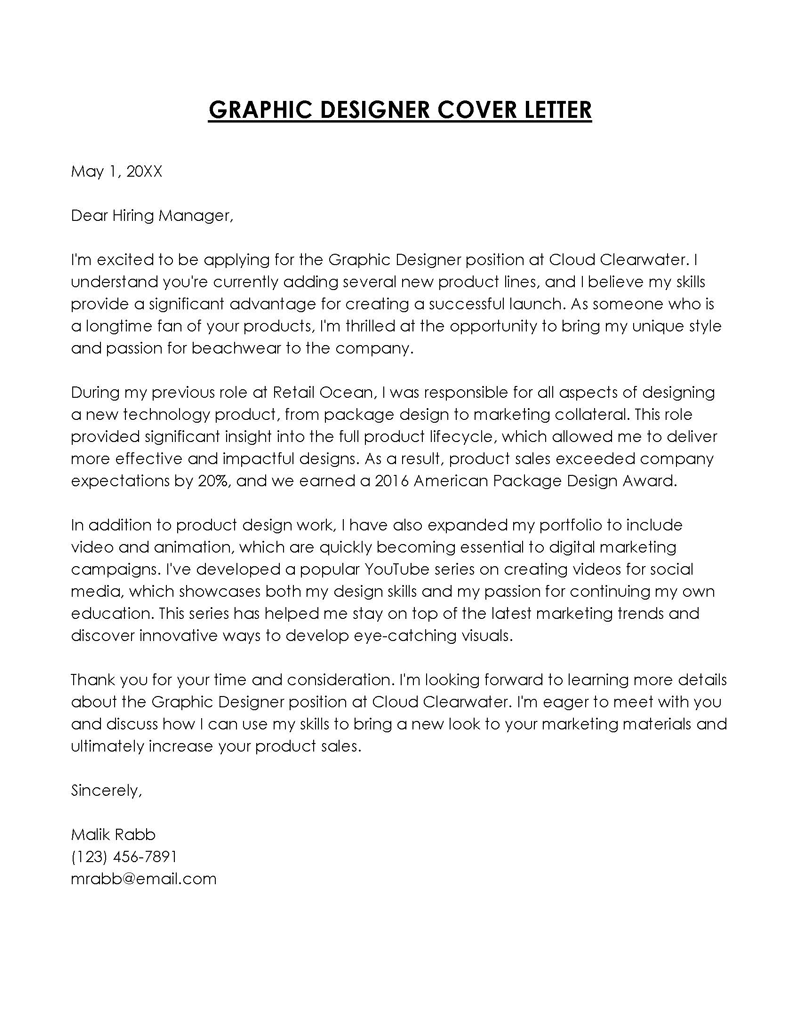
Best Practices for Cover Letters
Every open position attracts a large number of applications; as a result, your cover letter must show that you took the time to develop a compelling application that demonstrates your interest in working for the company in this position.
Using the techniques listed below, you can make your cover letter more effective:
Research the company
Before writing your cover letter, take the time to research the company and the job requirements. Look at the company’s website, social media accounts, and any other relevant information you can find. This will help you understand the company’s culture, mission, and values, and tailor your letter to fit the company’s needs.
Personalize your letter
Avoid using a generic cover letter that you send to every job you apply to. Instead, customize your letter to fit the company and job you are applying for. Use the information you gathered during your research to show the employer that you are genuinely interested in the company and the position.
Use appropriate tone
An essential tip while personalizing the cover letter is to pay attention to the tone of the hiring company, which can be observed through their communication. Identify if they are an energetic or relaxed company, and write your cover letter in the same tone. Companies are more likely to hire an applicant who understands the company’s culture.
Customize the letter
Your cover letter should have a professional but not excessively formal tone. If using a template, add more details to the document to customize it to suit your needs.
Keep it brief
While aiming for brevity and conciseness, the word count of your letter should be around 250 to 400 words. Focus on your relevant skills and qualifications while avoiding irrelevant information.
Pay attention to the layout and formatting
Your first opportunity to impress hiring managers with your design abilities is through your job application, which comprises your cover letter and resume. Use the same fonts, color codes, and configuration across both documents to create a cohesive and professional look.
Proofread and edit
Before submitting, ensure your letter has no spelling, grammar, or punctuation errors. You can ask a friend or family member to proofread it for you.
Wrapping Up
In conclusion, a well-written and visually appealing cover letter can be the key to landing your dream job. By following the tips and explanations given in this article, you can create a cover letter that not only showcases your design skills but also highlights your experience, accomplishments, and passion for the field. Remember to keep it concise, tailor it to the job description, and show off your unique style and creativity. With a strong cover letter, you can stand out from the competition and get one step closer to your dream job as a graphic designer.
